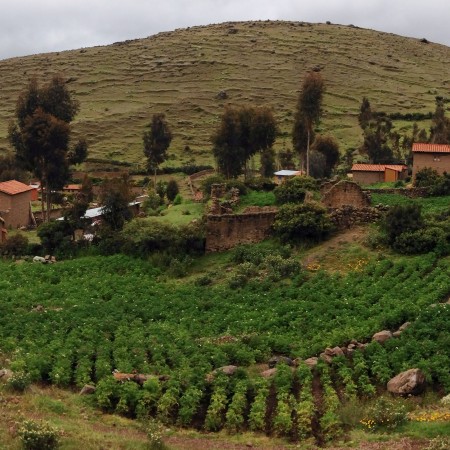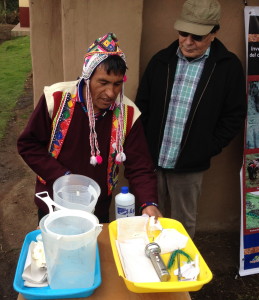- Where should we collect sweet potato wild relatives?
- Cheese made from toe bacteria. Because we can.
- The sainted M.S. Swaminathan on millets.
- FAO brings together dietary guidelines from around the world.
- An infographic on kale origins.
- Diversity down, productivity down. At least in Alaska.
- Cotton’s got a genome.
- McDonalds commits to ending deforestation in its supply chain.
- IUCN report says commercial agriculture and forestry could could actually be good for biodiversity. Hope McDonalds read it.
Brainfood: Resilience and diversity, Cold tolerant rice, Old baobabs, VIR, Local adaptation, Prunus phylogeny, Bactris mating, Land use change, Wheat landraces, Amazonian agrobiodiversity
- Does Plant Species Richness Guarantee the Resilience of Local Medical Systems? A Perspective from Utilitarian Redundancy. It depends on how knowledge is distributed.
- COLD1 Confers Chilling Tolerance in Rice. From a wild relative.
- Searching for the Oldest Baobab of Madagascar: Radiocarbon Investigation of Large Adansonia rubrostipa Trees. 1,600 years seems to be the record.
- Genetic resources of cultivated plants as the basis for Russia’s food and environmental security. VIR needs Roubles 425 million a year ($14.3 million).
- Using archaeogenomic and computational approaches to unravel the history of local adaptation in crops. Models say that adaptation to higher latitudes was rapid, simple (few genes) and unstable.
- Combining conservative and variable markers to infer the evolutionary history of Prunus subgen. Amygdalus s.l. under domestication. Almonds and peaches were domesticated on either side of the Central Asian Massif from different sections of the genus that had been there for 5 million years.
- Conservation implications of the mating system of the Pampa Hermosa landrace of peach palm analyzed with microsatellite markers. Bactris effective population size in genebanks is too small.
- Global effects of land use on local terrestrial biodiversity. Within-sample total terrestrial species diversity down by 13.6% globally. About the same for crop wild relatives?
- Exploiting genetic diversity from landraces in wheat breeding for adaptation to climate change. It would be a good idea.
- Household Agrobiodiversity Management on Amazonian Dark Earths, Oxisols, and Floodplain Soils on the Lower Madeira River, Brazil. Age of household head, size of household and area of land under cultivation predict amount of agricultural biodiversity managed.
Nibbles: Local earthworm, Public-private, Cassava double, Food prices, Amazonian rubber, Mongolian ag, Pacific roots, Potato CWR, Ugandan plantain, Galician brassicas, Contesting agronomy, Silver bullet
- Lamb ham: an easter tradition we can all get behind.
- Indian researchers market a new earthworm. Not to bring you down or anything.
- PPP are the new black. It says here.
- Cassava gets Big Data treatment. That’s kinda biotechnology too. But then you have to commercialize the stuff, right?
- “Food price shocks are both a determinant and effect of conflict.”
- Recognizing the “rubber soldiers”.
- Chinese experts tell Mongolians how to be more resilient to climate change. I hope it works out for them.
- New potato and sweet potato varieties for the Pacific come to CePaCT.
- Any of those potato varieties benefit from wild relatives?
- New plantain variety for Uganda.
- Galician genebank gets old brassicas. National genebank unavailable for comment. Actually, national genebank unavailable.
- “We can see the blinkered promotion and systematic ‘bigging-up’ of individual agricultural technologies, and their real or imagined impacts, as a direct result of the uncritical acceptance of the language of ‘impact at scale’.”
- Biotechnologist says we need biotechnology to feed world. QED.
Complementary potato conservation in the Parque de la Papa
 I was in South America for the past couple of weeks, which is why blogging has been, well, slow. One of the places I visited was the Parque de la Papa, or Potato Park, near Cusco in Peru, thus fulfilling a long-standing ambition. The Parque brings together six local communities around the imperative to conserve local potato diversity, both wild and cultivated, and use it sustainably. They raise money through ecotourism, including a restaurant serving local delicacies, but also through action research projects. One of the more important things that’s been happening is the “repatriation” of virus-free landraces from the genebank of the International Potato Centre (CIP), including with support from the International Treaty.
I was in South America for the past couple of weeks, which is why blogging has been, well, slow. One of the places I visited was the Parque de la Papa, or Potato Park, near Cusco in Peru, thus fulfilling a long-standing ambition. The Parque brings together six local communities around the imperative to conserve local potato diversity, both wild and cultivated, and use it sustainably. They raise money through ecotourism, including a restaurant serving local delicacies, but also through action research projects. One of the more important things that’s been happening is the “repatriation” of virus-free landraces from the genebank of the International Potato Centre (CIP), including with support from the International Treaty.
 CIP staff have also been training local people in the production of botanical seed, as part of a project implemented by the Asociación ANDES with support from the Global Crop Diversity Trust. The seed is being stored in a community genebank, but will be safety duplicated at CIP, and hopefully also eventually in Svalbard. The photo shows Pedro doing a demonstration of how seeds are extracted from fruits for storage. The guy on the right is Alejandro Argumedo of ANDES. Really good to see ex situ and on farm conservation working together and complementing each other, as they should.
CIP staff have also been training local people in the production of botanical seed, as part of a project implemented by the Asociación ANDES with support from the Global Crop Diversity Trust. The seed is being stored in a community genebank, but will be safety duplicated at CIP, and hopefully also eventually in Svalbard. The photo shows Pedro doing a demonstration of how seeds are extracted from fruits for storage. The guy on the right is Alejandro Argumedo of ANDES. Really good to see ex situ and on farm conservation working together and complementing each other, as they should.
Nibbles: Rabbit origins, New beans and rice, New maize, Fermentation, Grape bugs, Kenya supergoats, Peruvian edible insects, Betelmania, Sustainable cacao, Making cider, Land rights, Kew funding, Avocado origins, German genebank, Oman roadshow, Chinese agriculture then and now, Underground farm, Irish potatoes, Lactase history, Nutrition report, Breeding wheat, Pulse year, Perennial cereals, Shaker agriculture, Food conference, Lupin breeding, Tanzanian ag landscapes, Coffee film, American food, Breakfast around the world, Indian wild figs, Baobab, Fragmentation, History of breeding, MARDI fruits, IARI head, Wild pig genome, Breed typology
Yeah, I know, been slacking with the blogging again of late. Lots of travel. Will try to post about it a bit now I’m back. Here’s the usual back-in-the-office game of catch-up.
- We start with something topical for Easter. The origin of the bunny: it’s not the genes, it’s the gene control control.
- CIAT’s heat-resistant beans are all over the internet. IRRI’s new rices, not so much.
- I hope they get names like Bill Tracy’s new open-pollinated maize variety.
- Bugs come in communities, and they do best when they stay that way.
- Even on grapes.
- Gotta get me one of these Kenyan supergoats.
- Are bugs next on Peru’s gastronomia menu? Probably not.
- Ban the betel!
- More on that we-need-GMO-to-save-chocolate thing. Because this?
- Some like it hard.
- Three steps to secure land rights.
- “If the seeds are never grown, they will fizzle out. Who is going to sow them and harvest them to keep them fresh?”
- The avocado shouldn’t be here. So sue me.
- The Ghana News Agency (and nobody else) says there’s a new genebank in Berlin.
- Oman’s biodiversity (including agricultural) goes on the road.
- Chinese agriculture goes sustainable. Well, in theory. Including for buckwheat, presumably.
- Maybe you can work out what this early Chinese flour was actually of: millet, barley and/or wheat?
- Meanwhile, in Japan, the opposite of sustainable farming beneath a Tokyo street.
- The Irish and the potato: in need of a reset?
- Want to develop? Learn to metabolize lactose.
- Ten research questions on nutrition.
- Well at least this gluten nonsense 1 is helping bring back some funky grains. And is spurring breeders. Who should perhaps be focusing on more important problems?
- Pulses will get their 15 minutes in 2016.
- The Land Institute is still at it, and still getting press.
- The United Society of Believers in Christ’s Second Appearing established one of the earliest seed companies in the US.
- No, getting to the bottom of food ain’t easy.
- Lupins better than soya in the UK, because breeding.
- A Tanzanian mash-up: Farmers need the landscape. I’m not kidding. And yet…
- There’s a film about coffee called “A film about coffee.”
- “In the future, the American dream of big cars and burgers will need to be adjusted to more active transport and sustainable, healthy eating. Better is the new bigger. The world needs a new diet. And it is waiting for the US to take the lead.” Good luck with that.
- Maybe start with breakfast?
- Indians need their wild figs.
- As much a African need baobabs, probably.
- A fragmented forest is no forest at all. Well, almost.
- BHL does domestication. As ever, great pix too.
- Malaysia protects its fruits.
- Who will head the Indian Agricultural Research Institute?
- The pygmy hog has been sequenced.
- A typology of livestock breeds.